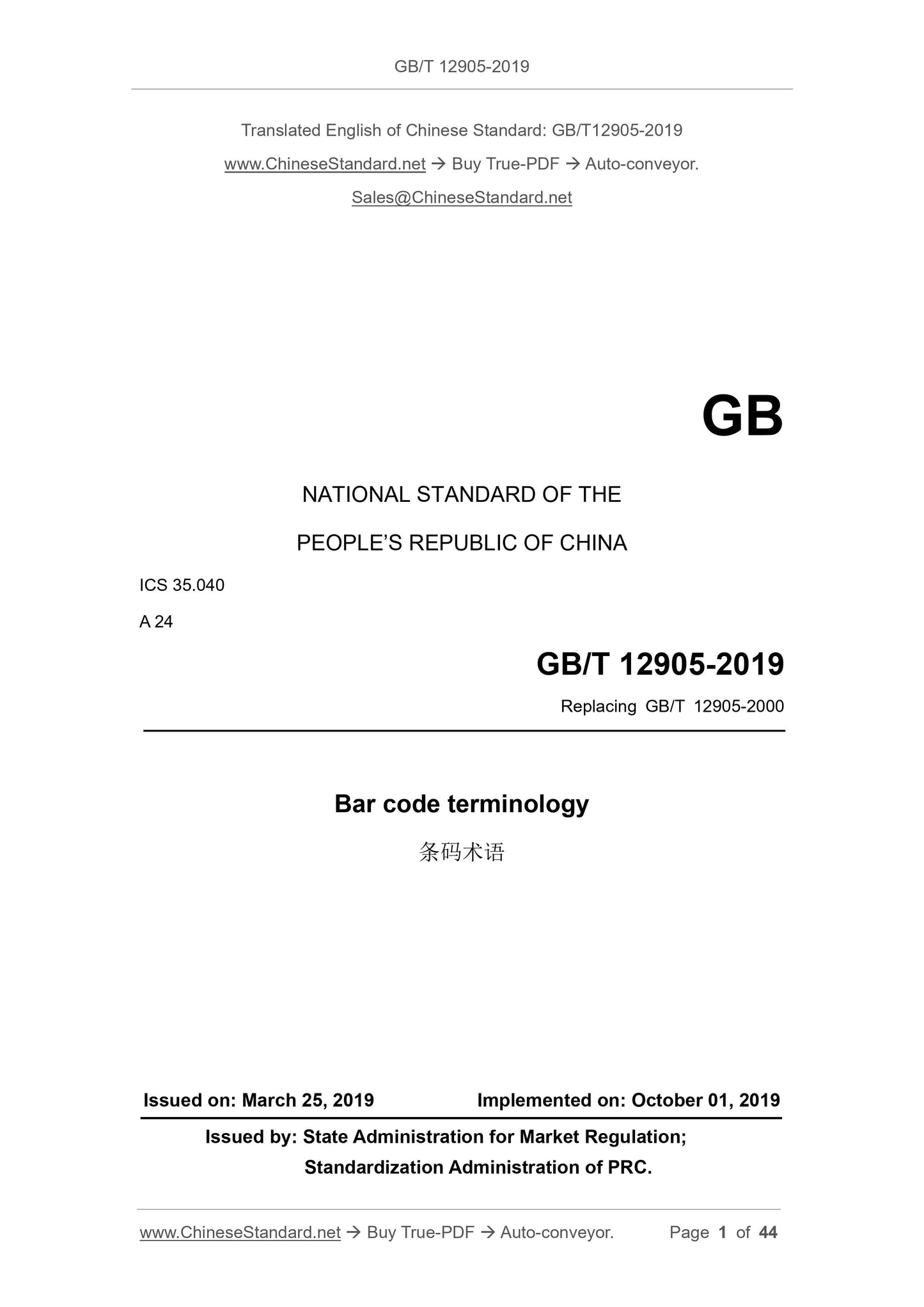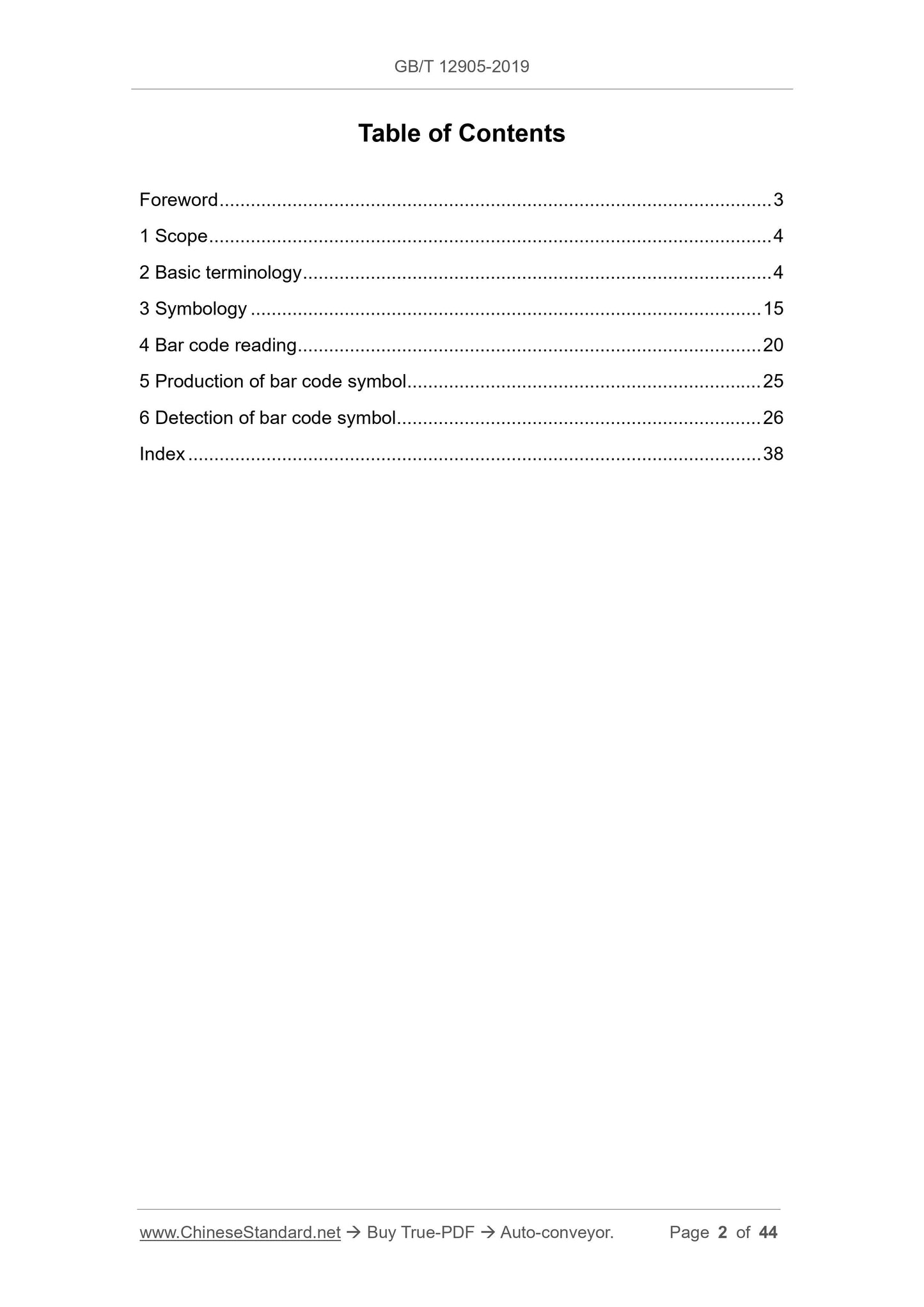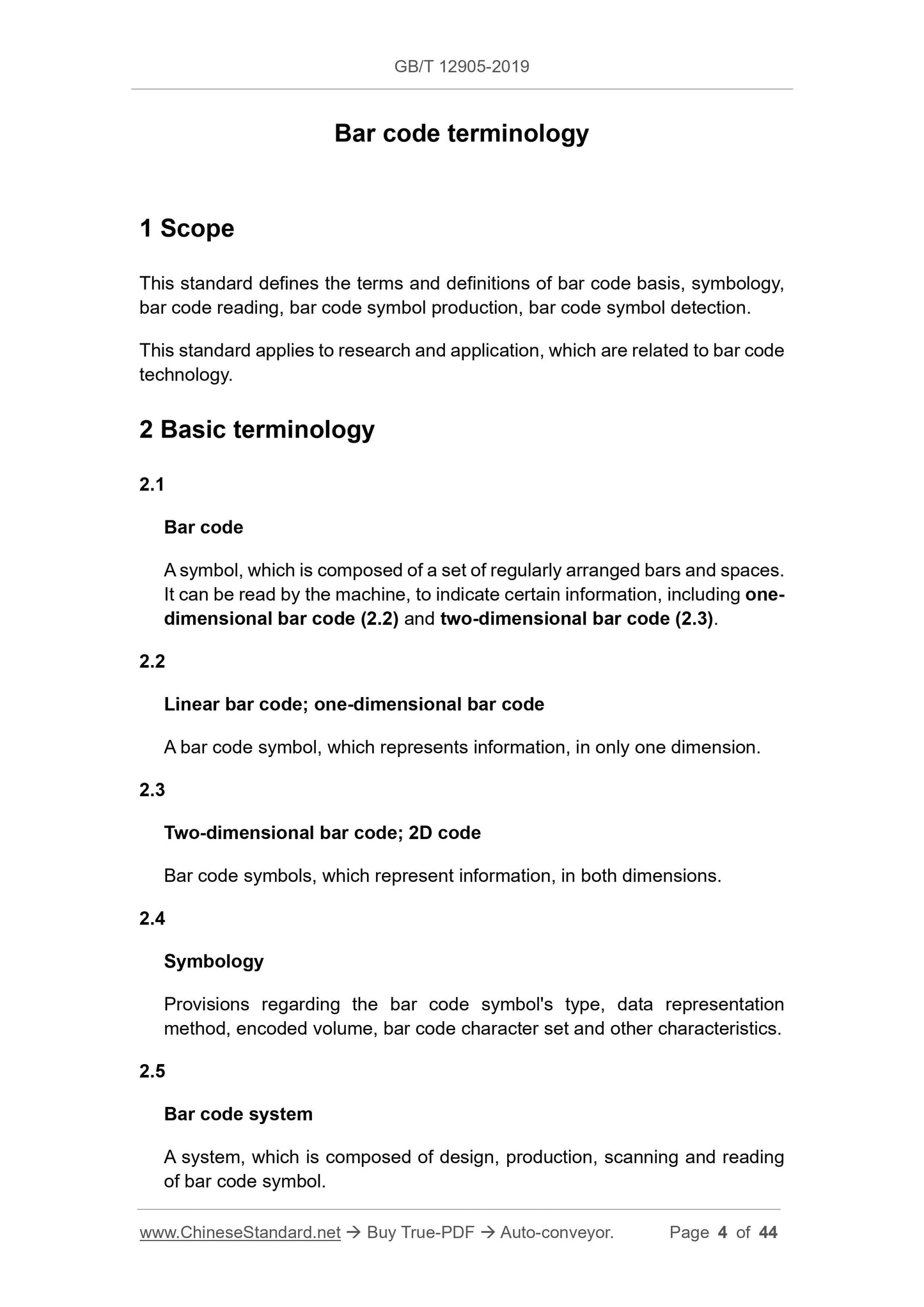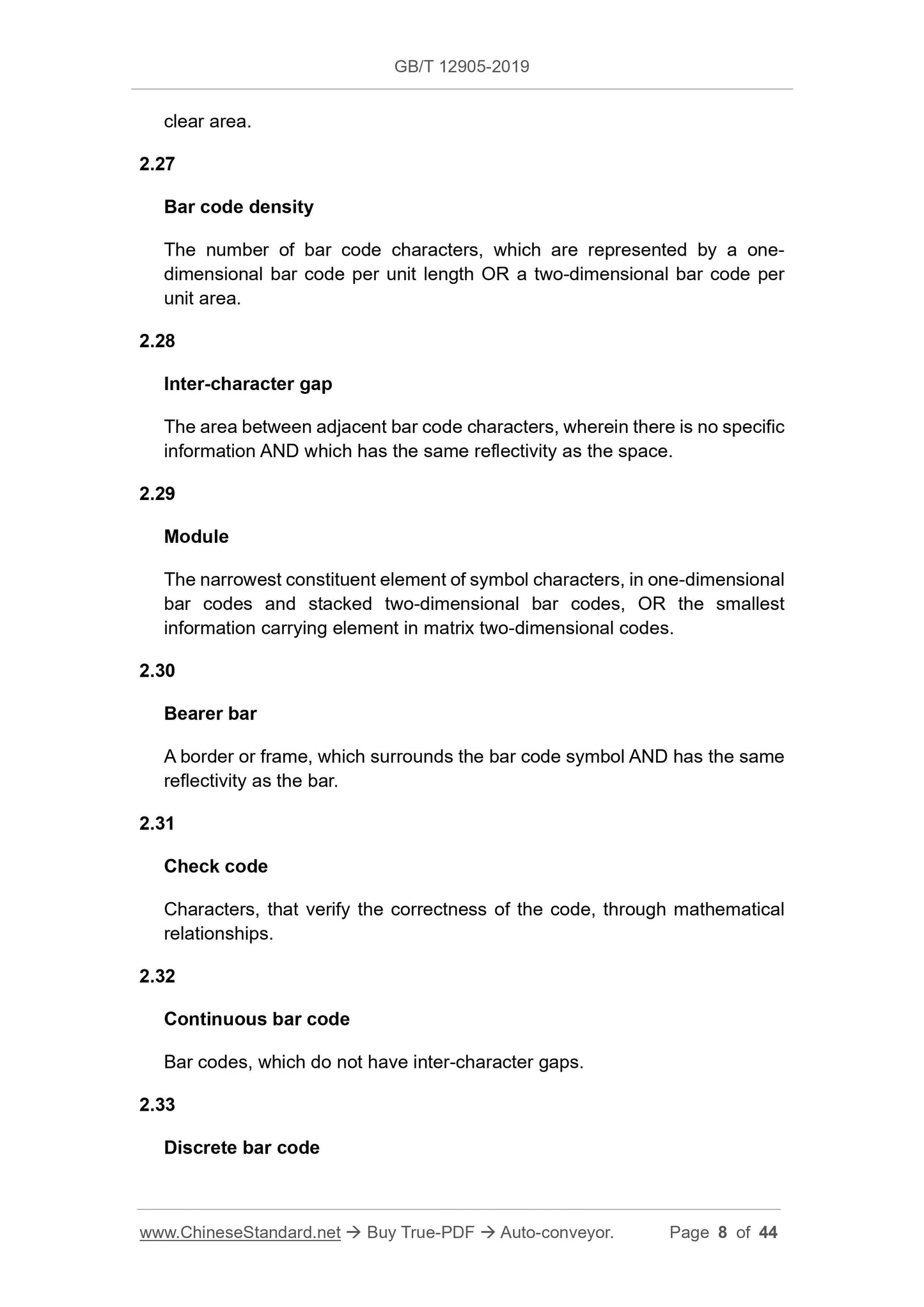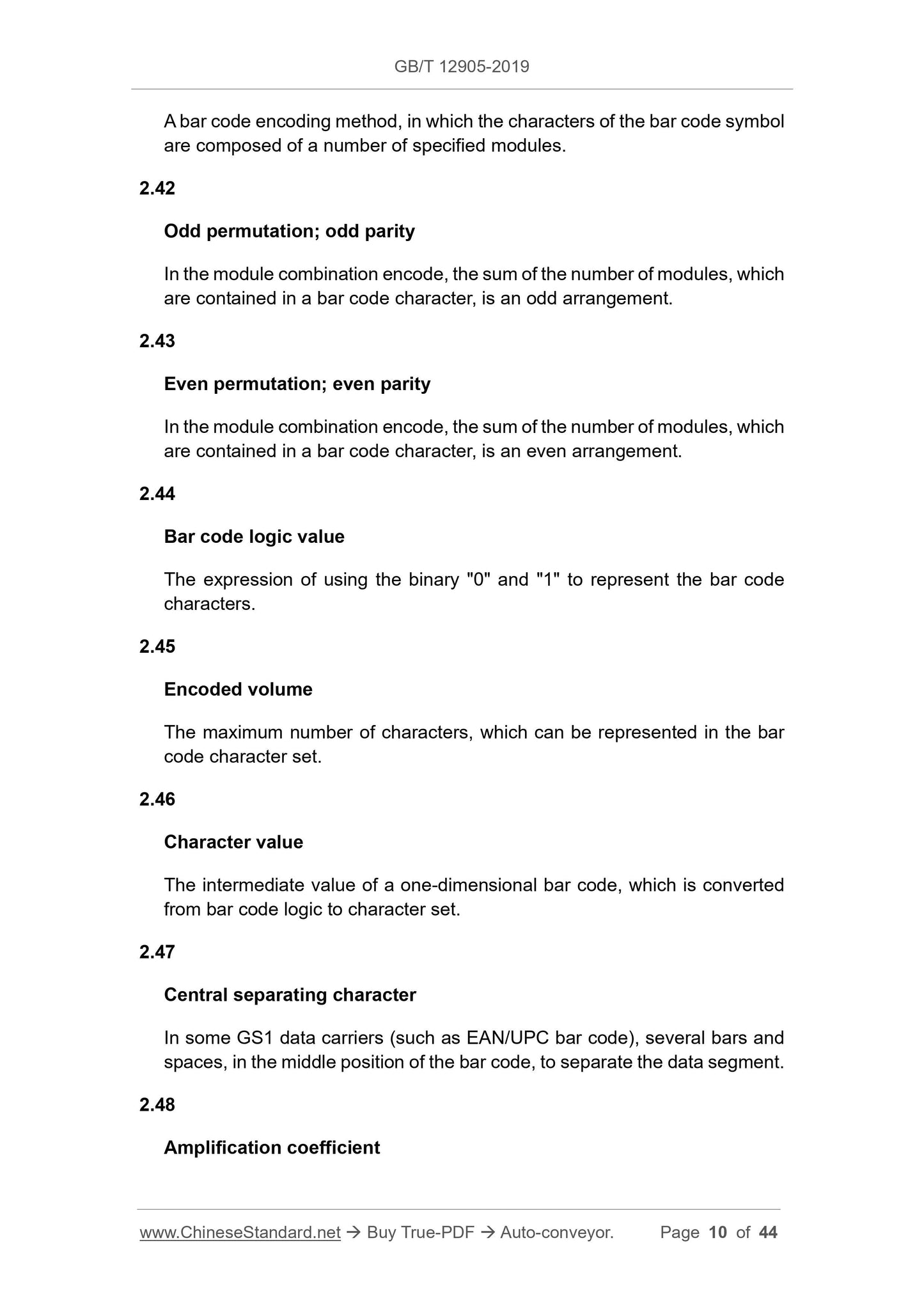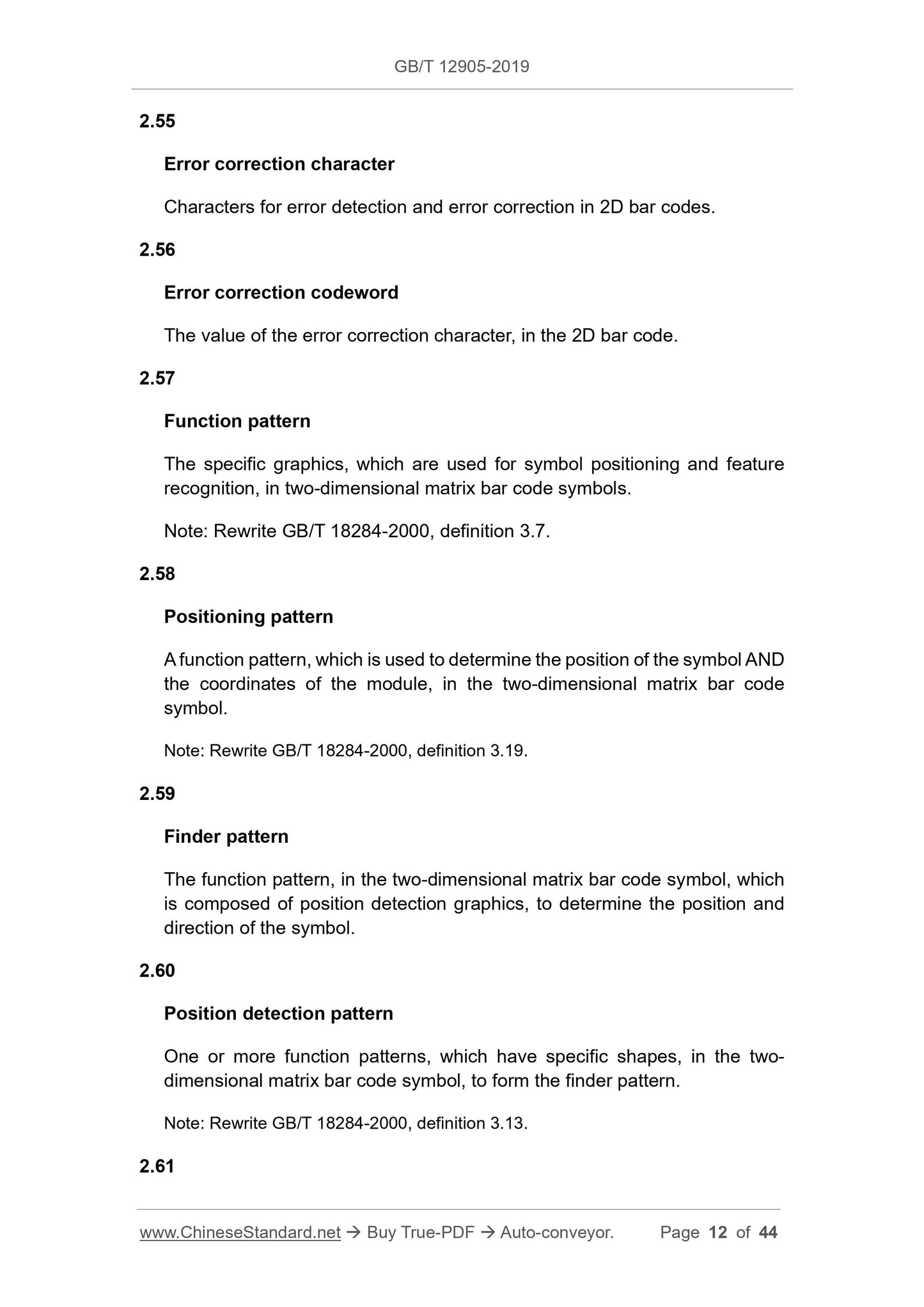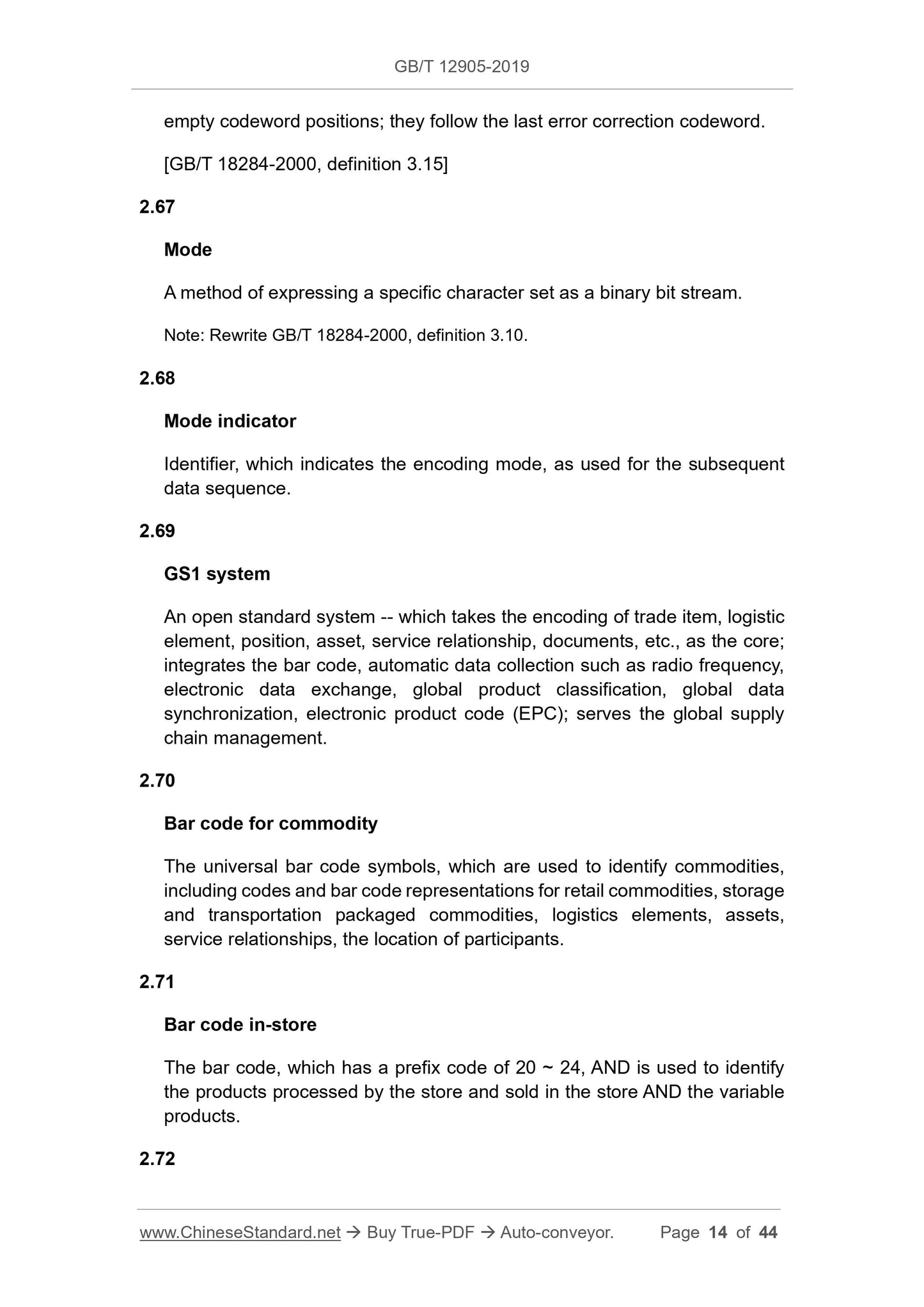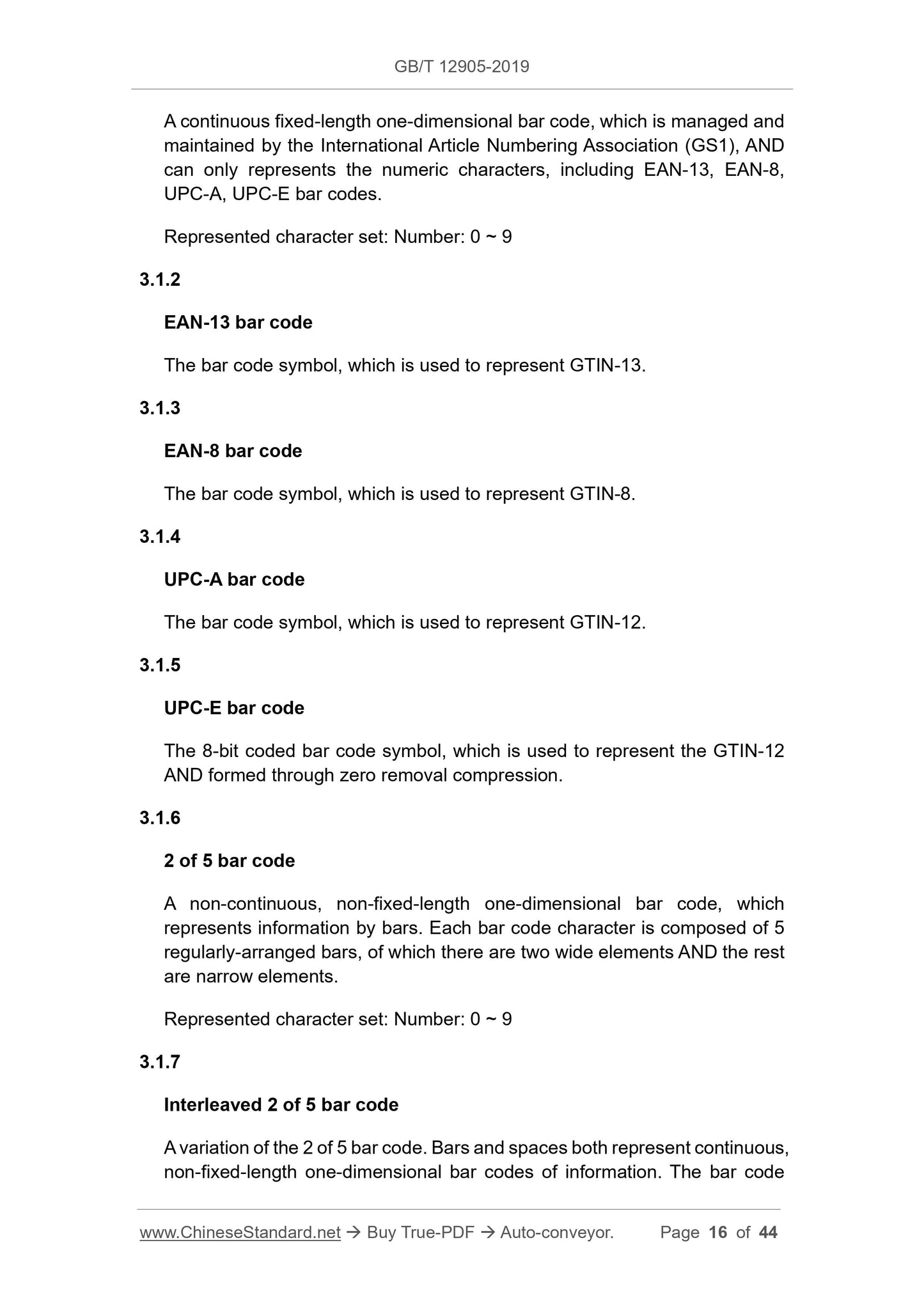1
/
of
8
PayPal, credit cards. Download editable-PDF and invoice in 1 second!
GB/T 12905-2019 English PDF (GBT12905-2019)
GB/T 12905-2019 English PDF (GBT12905-2019)
Regular price
$500.00 USD
Regular price
Sale price
$500.00 USD
Unit price
/
per
Shipping calculated at checkout.
Couldn't load pickup availability
Delivery: 3 seconds. Download true-PDF + Invoice.
Get Quotation: Click GB/T 12905-2019 (Self-service in 1-minute)
Historical versions (Master-website): GB/T 12905-2019
Preview True-PDF (Reload/Scroll-down if blank)
GB/T 12905-2019: Bar code terminology
GB/T 12905-2019
Bar code terminology
ICS 35.040
A24
National Standards of People's Republic of China
Replace GB/T 12905-2000
Barcode terminology
Released on.2019-03-25
2019-10-01 implementation
State Administration for Market Regulation
Issued by the National Standardization Administration of China
Table of contents
Foreword Ⅲ
1 Scope 1
2 Basic terminology 1
3 Symbology 7
4 Barcode reading 9
5 Barcode symbol production 12
6 Barcode symbol detection 12
Index 19
Preface
This standard was drafted in accordance with the rules given in GB/T 1.1-2009.
This standard replaces GB/T 12905-2000 "Barcode Terminology". Compared with GB/T 12905-2000, the main technical changes of this standard
as follows.
---Adjust the scope of the original standard and arrange it according to the system, divided into. scope, basic terminology, symbology, barcode reading, barcode symbol production, barcode
Symbol detection, a total of six parts.
---Added two-dimensional barcode, commodity barcode and other related terms, adding a total of 75 entries.
---Removed 34 non-generic terms.
---Revised the explanation of 43 items.
This standard was proposed and managed by the National Logistics Information Management Standardization Technical Committee (SAC/TC267).
Drafting organizations of this standard. China Article Coding Center, Ningbo Ningbo Standard Article Coding Center, Ningbo Institute of Standardization, Zhejiang Article Code
Code Center, Beijing Jiaotong University, Shandong Institute of Standardization, Qingdao Institute of Standardization, Hebei Institute of Standardization, Xinjiang Uyghur
Autonomous Region Standardization Research Institute, Shaanxi Standardization Research Institute, Henan Standardization Research Institute, Chongqing Quality and Standardization Research Institute, Shanxi Province
Standardization Research Institute, Inner Mongolia Autonomous Region Standardization Institute, Imagine Things (Beijing) Technology Development Co., Ltd.
The main drafters of this standard. Li Sucai, Lou Qinghua, Zhu Yuefeng, Du Jingrong, Ge Weisan, Ruan Xiaohua, Ding Wei, Hou Hanping, Han Shuwen,
Zhang Yongpei, Xing Yanlin, Li Congfen, Liu Lizhen, Liao Quanhong, He Guoqing, Ning Jirong, Gao Juan, Chen Zhenyu, Zhang Qiuxia, Gu Haitao, Zhang Hong.
The previous versions of the standard replaced by this standard are as follows.
---GB/T 12905-1991, GB/T 12905-2000.
Barcode terminology
1 Scope
This standard defines the terms and definitions of barcode foundation, symbology, barcode reading, barcode symbol production, and barcode symbol detection.
This standard applies to research and application related to bar code technology.
2 Basic terminology
2.1
Barcode
A symbol composed of a set of regularly arranged bars and spaces, which can be read by machines to indicate certain information, including one-dimensional bar codes (2.2) and
Two-dimensional barcode (2.3).
2.2
One-dimensional barcode linearbarcode;one-dimensionalbarcode
A bar code symbol that represents information in only one dimension.
2.3
Two-dimensional barcode; 2Dcode
QR code
Barcode symbols that represent information in both dimensions.
2.4
Symbology
Provisions on the characteristics of the bar code symbol type, data representation method, encoding capacity and bar code character set.
2.5
Barcodesystem
A system composed of barcode symbol design, production and scanning and reading.
2.6
Bar; darkbar; blackbar
The part of the barcode symbol with lower reflectivity.
2.7
Empty space; lightbar
The part of the bar code symbol with higher reflectivity.
2.8
Start character startcharacter;startcipher;startcode
Several bars and spaces at the beginning of the bar code symbol.
2.9
Stopcharacter;stopcipher;stopcode
Several bars and spaces at the end of the bar code symbol.
2.10
Cleararea;quietzone;quietarea;clearzone
A limited area with the same reflectivity on the outside of the barcode symbol as the empty space.
Note. The blank area of the one-dimensional barcode is located outside the start and end characters, and the blank area of the two-dimensional barcode is located on both sides or around the symbol of the two-dimensional barcode.
2.11
Barcode symbol
An information symbol composed of a bar code and a blank area or a protective frame.
2.12
Characterset
A collection of letters, numbers, and symbols that can be represented by a barcode symbol.
2.13
Separator
Delimiter
A special character used as a separator in the bar code.
2.14
Barcodecharacter
A combination of several bars and spaces arranged according to a certain rule is used to represent a number, letter or symbol.
2.15
Barcodecharacterset
A collection of characters that can be represented by a certain barcode.
2.16
Barcode data character barcodedatacharacter
Bar code characters that represent specific information.
2.17
Barcode checkcharacter barcodecheckcharacter
The barcode character that represents the check code.
2.18
Element
Bars or spaces that make up barcode characters.
2.19
Barheight
The height dimension of the bar perpendicular to the width of the cell.
2.20
Barwidth
The width dimension of the bar in the bar code character.
2.21
Spacewidth
The width dimension of the bar code characters.
2.22
Barwidthratio
The ratio of the width of the widest bar to the narrowest bar in a barcode.
2.23
Spacewidthratio
The ratio of the width of the widest space to the narrowest space in a barcode.
Get Quotation: Click GB/T 12905-2019 (Self-service in 1-minute)
Historical versions (Master-website): GB/T 12905-2019
Preview True-PDF (Reload/Scroll-down if blank)
GB/T 12905-2019: Bar code terminology
GB/T 12905-2019
Bar code terminology
ICS 35.040
A24
National Standards of People's Republic of China
Replace GB/T 12905-2000
Barcode terminology
Released on.2019-03-25
2019-10-01 implementation
State Administration for Market Regulation
Issued by the National Standardization Administration of China
Table of contents
Foreword Ⅲ
1 Scope 1
2 Basic terminology 1
3 Symbology 7
4 Barcode reading 9
5 Barcode symbol production 12
6 Barcode symbol detection 12
Index 19
Preface
This standard was drafted in accordance with the rules given in GB/T 1.1-2009.
This standard replaces GB/T 12905-2000 "Barcode Terminology". Compared with GB/T 12905-2000, the main technical changes of this standard
as follows.
---Adjust the scope of the original standard and arrange it according to the system, divided into. scope, basic terminology, symbology, barcode reading, barcode symbol production, barcode
Symbol detection, a total of six parts.
---Added two-dimensional barcode, commodity barcode and other related terms, adding a total of 75 entries.
---Removed 34 non-generic terms.
---Revised the explanation of 43 items.
This standard was proposed and managed by the National Logistics Information Management Standardization Technical Committee (SAC/TC267).
Drafting organizations of this standard. China Article Coding Center, Ningbo Ningbo Standard Article Coding Center, Ningbo Institute of Standardization, Zhejiang Article Code
Code Center, Beijing Jiaotong University, Shandong Institute of Standardization, Qingdao Institute of Standardization, Hebei Institute of Standardization, Xinjiang Uyghur
Autonomous Region Standardization Research Institute, Shaanxi Standardization Research Institute, Henan Standardization Research Institute, Chongqing Quality and Standardization Research Institute, Shanxi Province
Standardization Research Institute, Inner Mongolia Autonomous Region Standardization Institute, Imagine Things (Beijing) Technology Development Co., Ltd.
The main drafters of this standard. Li Sucai, Lou Qinghua, Zhu Yuefeng, Du Jingrong, Ge Weisan, Ruan Xiaohua, Ding Wei, Hou Hanping, Han Shuwen,
Zhang Yongpei, Xing Yanlin, Li Congfen, Liu Lizhen, Liao Quanhong, He Guoqing, Ning Jirong, Gao Juan, Chen Zhenyu, Zhang Qiuxia, Gu Haitao, Zhang Hong.
The previous versions of the standard replaced by this standard are as follows.
---GB/T 12905-1991, GB/T 12905-2000.
Barcode terminology
1 Scope
This standard defines the terms and definitions of barcode foundation, symbology, barcode reading, barcode symbol production, and barcode symbol detection.
This standard applies to research and application related to bar code technology.
2 Basic terminology
2.1
Barcode
A symbol composed of a set of regularly arranged bars and spaces, which can be read by machines to indicate certain information, including one-dimensional bar codes (2.2) and
Two-dimensional barcode (2.3).
2.2
One-dimensional barcode linearbarcode;one-dimensionalbarcode
A bar code symbol that represents information in only one dimension.
2.3
Two-dimensional barcode; 2Dcode
QR code
Barcode symbols that represent information in both dimensions.
2.4
Symbology
Provisions on the characteristics of the bar code symbol type, data representation method, encoding capacity and bar code character set.
2.5
Barcodesystem
A system composed of barcode symbol design, production and scanning and reading.
2.6
Bar; darkbar; blackbar
The part of the barcode symbol with lower reflectivity.
2.7
Empty space; lightbar
The part of the bar code symbol with higher reflectivity.
2.8
Start character startcharacter;startcipher;startcode
Several bars and spaces at the beginning of the bar code symbol.
2.9
Stopcharacter;stopcipher;stopcode
Several bars and spaces at the end of the bar code symbol.
2.10
Cleararea;quietzone;quietarea;clearzone
A limited area with the same reflectivity on the outside of the barcode symbol as the empty space.
Note. The blank area of the one-dimensional barcode is located outside the start and end characters, and the blank area of the two-dimensional barcode is located on both sides or around the symbol of the two-dimensional barcode.
2.11
Barcode symbol
An information symbol composed of a bar code and a blank area or a protective frame.
2.12
Characterset
A collection of letters, numbers, and symbols that can be represented by a barcode symbol.
2.13
Separator
Delimiter
A special character used as a separator in the bar code.
2.14
Barcodecharacter
A combination of several bars and spaces arranged according to a certain rule is used to represent a number, letter or symbol.
2.15
Barcodecharacterset
A collection of characters that can be represented by a certain barcode.
2.16
Barcode data character barcodedatacharacter
Bar code characters that represent specific information.
2.17
Barcode checkcharacter barcodecheckcharacter
The barcode character that represents the check code.
2.18
Element
Bars or spaces that make up barcode characters.
2.19
Barheight
The height dimension of the bar perpendicular to the width of the cell.
2.20
Barwidth
The width dimension of the bar in the bar code character.
2.21
Spacewidth
The width dimension of the bar code characters.
2.22
Barwidthratio
The ratio of the width of the widest bar to the narrowest bar in a barcode.
2.23
Spacewidthratio
The ratio of the width of the widest space to the narrowest space in a barcode.
Share
